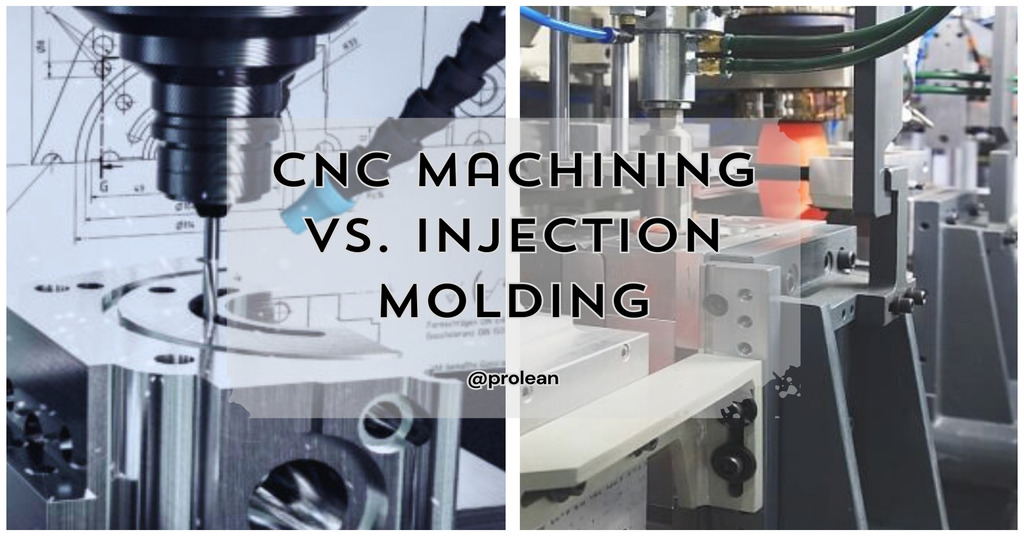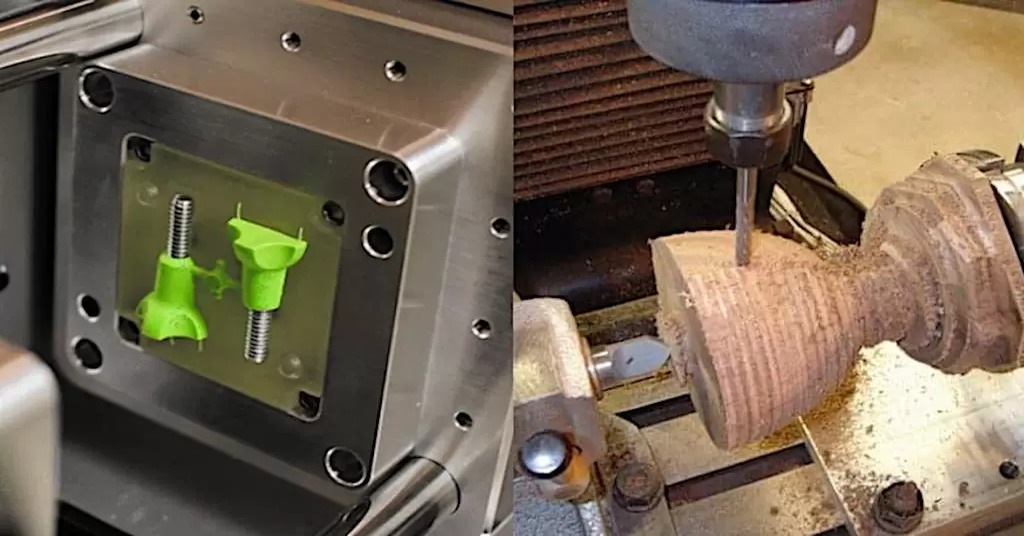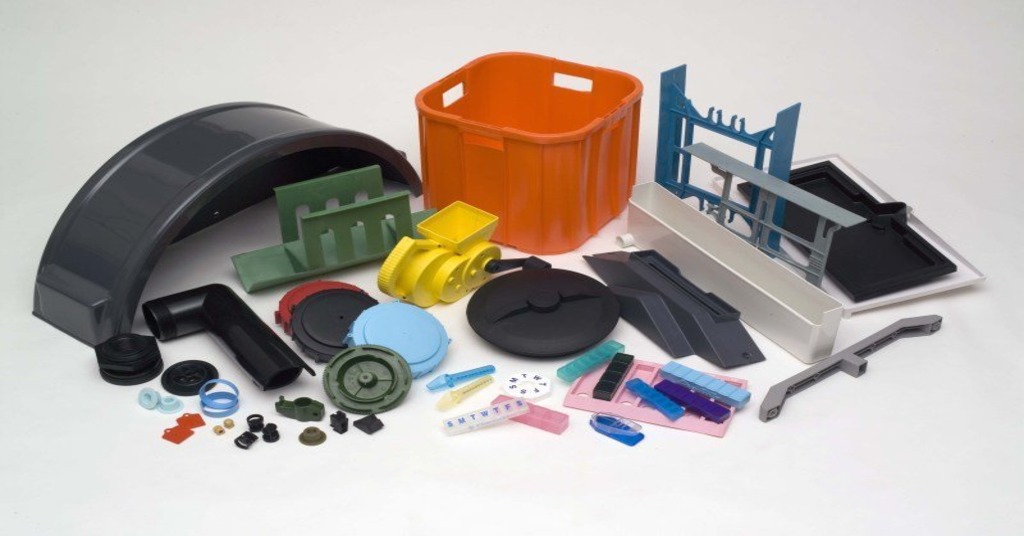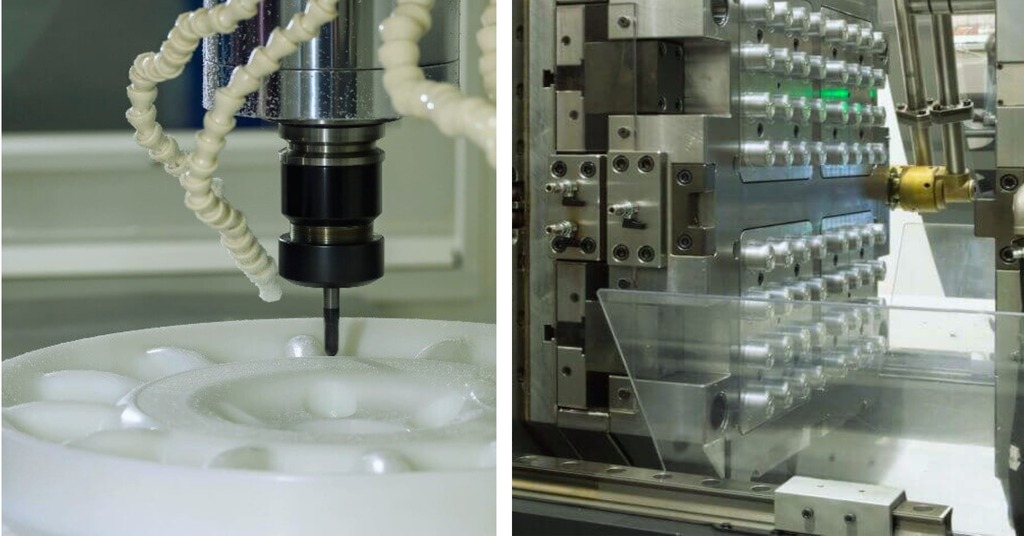“Choose CNC machining when your design demands precision and flexibility in materials and quantities. Opt for injection molding when your vision scales to the horizon, requiring volumes in millions.”

When it comes to selecting, there are multiple determinants such as material, complexity, time requirement costs, etc. Both are widely applicable in various industries and have different means of crafting from each other. CNC machining, known as a subtractive manufacturing process, uses cutters to shape material, while injection molding uses liquid material feeding to produce finalized components. The ultimate decision will depend upon your project specifications and requirements like production volumes, parts precision, and dimensional tolerances.
Therefore, in this article, we will deliberately analyze the details of CNC machining Vs. Injection molding. Additionally, we will discuss the competitiveness, merits, and demerits of both processes
CNC Machining vs. Injection Molding: Definitive Difference
The major difference is that CNC machining takes away material, while Injection molding hand adds material to fabrication. CNC machining uses multiple materials and processes such as drilling, milling, lathes, and cutting to draft a component. The computerized aided designs, programming, and use of additional software increase the precision, quality, and optimization level.

CNC machining Vs. Injection molding
The designs are created on CAD/CAM software, and then instructions are forwarded in the form of G-codes to different machines to execute the operation. The smooth transition between digital designs and physical parts plays a vital role in this process.
In contrast, Injection molding includes the injection of molten material, most prominently thermoplastics, into a die or mold to produce a component. Then, the pre-heated molten material is fed into the mold through runners into the mold which afterward cools down and solidifies.
Upon completion, the mold is carefully opened and the casted part is removed to restart the process again. Well-designed mold and sturdy plastic raisins are essential components of this process.
Comparative Analysis of CNC Machining vs. Injection Molding
The strengths and limitations of CNC machining vs. injection molding processes make them well fit for some applications over others. Although, they are considered efficient and are tremendously used in manufacturing facilities.
1. Material Options
CNC machining accommodates a wide range of materials from metal to plastic. The material hardiness is a key consideration for plastic material. CNC machines can easily fabricate hard plastic, while soft plastic will be deformed. Therefore, high tolerance, workability, and precision can only be achieved on hard materials.

Plastic products made through injection molding
On the contrary, injection molding is free from these limitations and has flexible machinability for soft materials. So, if you want to work with thermoplastics or other injection molded materials such as Polyether Ether Ketone (PEEK), Acrylonitrile Butadiene Styrene (ABS), Polypropylene (PP), which can be molded without losing material strength, injection molding is the right choice. Pliable and flexible materials can be forged with this process.
2. Production costs, time, and volumes
The two of these processes are exploited for large production volumes. Rapid prototyping with CNC machining can easily be accomplished early based on the material in hand. However, cost reduction for higher production volumes is relatively high through CNC machining and may need an extended period for completion.
Injection molding in contrast can be used for rapid prototyping for smaller machines. It is a better option for large production volumes and justifies cost reduction much more efficiently. The only time injection molding is needed is in designing custom molds. Therefore, injection molding seems more economical as compared to CNC machining.
3. Quality-controlled Manufacturing
Injection molding and CNC machining both are capable of producing top-quality products. Whereas, the high tolerance and good surface finishing can only be obtained by CNC machines. The level of control in this process increases the precision, tolerance, and quality of the product.
With injection molding, there is a risk of damage when the product is placed under stress. For instance, vacuum voids, flow lines, burn marks, and wrapping are common defects associated with injection molding. And, also it needs additional cost of finishing.
4. Design Flexibility
When it comes to design flexibility, CNC machining is considered the best choice among manufacturers. Every engineer desires the feasibility of post-manufacture changes in the obtained part. Therefore, additional changes can be easily made in CNC-driven products although CAD files should be updated before changes.
In CNC machining vs. injection molding, If we analyze injection molding from a flexibility point of view, a new mold would be needed in case of additional modification which in turn adds additional cost. In order to make small or medium products, injection molding can be used. Due to these limitations in injection molding, CNC machining is much more preferable.
Let’s understand CNC Machining and Injection Molding based on various factors:
Table: Comparison of CNC machining and Injection molding processes
| Factors | CNC Machining | Injection Molding |
| Process | Removes material from a solid block using cutting tools. | Injects molten material into a mold cavity to form a part. |
| Costs | Higher initial setup costs, but lower per-unit costs for low to medium volumes. | Higher initial tooling costs, but lower per-unit costs for high volumes. |
| Dimensions | Can handle large parts, but limited by machine bed size. | Limited to the size of the mold cavity. |
| Tolerances | Achieves tight tolerances, typically ±0.005 inches for metals and ±0.002 inches for plastics. | Tolerances are influenced by factors such as material, mold design, and process parameters, typically ±0.010 inches or higher. Source |
| Material Range | Wide range including metals, plastics, composites, and more. | Limited to materials that can be melted and injected, primarily plastics. |
| Precision | Capable of producing highly precise parts with intricate details. | Can achieve precision depending on mold design and process parameters. |
| Accuracy | Accurate within specified tolerances, repeatable. | Accurate within specified tolerances, consistency may vary. |
| Complexity Handling | Can handle complex geometries with multiple axes of movement. | Limited by mold design and part ejection requirements, simpler geometries are preferred. |
| Applications | Prototyping, low to medium volume production, high precision parts. It is employed by aerospace, robotics, and automation industries. | High-volume production of identical parts, parts with simpler geometries. It serves the automotive, pharmaceutical, Food, and beverage industries. |
| Lead Time | Longer lead times for complex parts due to programming and setup. | Shorter lead times once tooling is complete, longer lead times for tooling development. |
Click here to download: CNC Prototyping VS Injection Molding ProtoTyping for ThermoPlastics
Advantages of CNC Machining
Here are some of the benefits offered by CNC machining.
- In CNC machining every process parameter is optimized, so it’s easy to achieve high tolerance and good surface finishing.
- It is flexible with a wide range of materials from metal to plastic to efficiently produce parts.
- The computerized programming in CNC machines offers modifications in the successive part manufacturing according to your needs. Therefore, you can change program instructions to remodel your components.
Disadvantages of CNC Machining
The few disadvantages offered by CNC machining are the following:
- Cost per piece and production volumes require a high budget for CNC machining. Although, in the longer run the cost can be optimized.
- It’s a labor-intensive process, since the tool holders, completed parts, tools, and workpieces are constantly fixed and removed during the production process.
- Only trained engineers can proficiently execute CNC operations, so you need multiple expert personnel for large production runs.
Advantages of Injection Molding
Multiple advantages offered by injection molding are listed below:
- It can rapidly produce large volumes in a considerably short amount of time. Moreover, multiple-cavity molds are capable of fabricating numerous parts in one cycle.
- Most importantly, the production cost per piece is much lower concerning CNC machines.
- In injection molding, the post-processing stipulations are minimal. The Manufactured goods are ready for shipment immediately after production.
Disadvantages of Injection Molding
Some of the disadvantages of injection molding are detailed below:
- Injection molding doesn’t allow design flexibility. As a result, If certain changes are required in the next production cycle, you have to build a new mold or dye for that modification.
- It is entirely dependent on mold designs, any imperfection in the mold leads to a whole batch of defective components in large production cycles.
- High investment is needed for fabricating mold designs; the cost of multi-cavity molds can be between a few hundred to thousands of dollars.
What is the Difference between Compression Molding and Injection Molding?
Compression molding vs injection molding both are manufacturing processes, although their operating mechanisms are different from one another. The first and foremost difference between compression molding vs Injection molding is the approach through which the material is converted into shape. In injection molding, the molten material is poured into the mold cavity, cooled, and solidified after. On the other hand, in compression molding, high temperature, and pressure are the key elements that determine the component shape.
The products manufactured by compression molding are highly durable and stable concerning injection molding whose major focus is on producing complex designs.
CNC Plastic Machining vs Injection Molding: Key Differences

CNC plastic machining vs injection molding
When it comes to CNC plastic machining vs. injection molding, there are some critical operation differences between these two. In plastic CNC machining, the solid plastic blocks are placed inside a machine that uses different tools such as cutters, drills, and millers to design the product. These tools are driven by machine codes that direct the fabrication process.
While injection molding uses molten plastic material to shape the final product. The molten plastic is injected inside the mold, where it solidifies to obtain the desired shape. It is an easy, cost-effective, and fast process.
Get an Expert’s Opinion about Production Design from Prolean
Pro-lean: as expert manufacturers in this industry, we offer the best consultancy and production services. Our industrial knowledge and team of engineers will customize your sophisticated designs more innovatively. We craft parts with an elevated level of precision, tolerance, and durability. Additionally, we deal with a wide range of materials from metal to plastics, etc.
If you want to explore your options about which technique to choose, we will provide the best solution. So, contact us right now and get a free quote.
Read more:
- CNC Machining: Best Approaches for Manufacturing
- How much does injection molding Cost?
- 3D Printing Vs. Injection molding: Choose the best method for your project
- What is CNC Machining of PVC?
- Medical Injection Molding: Process, Materials and Applications
- What is CNC Drilling? Working, Advantages, and Applications
Summing Up
The injection molding and CNC machining are renowned manufacturing processes widely acceptable and applicable in producing intricate components. The comparative analysis of CNC machining vs. injection molding comprehends the competitiveness of these processes such as costs, production runs, design flexibility, and tolerance; much more. Both of these processes have certain merits and limitations that should be considered before considering one of them.
Well, the CNC machines allow more control and machinability which is why it is mostly considered over injection molding for the production of specific parts requiring high tolerance, precision, and durability. In contrast, Injection molding is more appropriate for lightweight, simple to complex, low-cost, and speedy production of components.
FAQs
Which Process is Best for Manufacturing Plastic Parts?
As mentioned above, injection molding is much more suitable for plastic part manufacturing. It is cost-effective and fast in fabricating high production volumes. Depending upon your need, you can use CNC machining also due to its flexibility, precision, and high tolerance level but it will be expensive.
What are the Similarities between Injection Molding and CNC Machining?
The main likeness between these processes is that they can use the same material, for instance, plastics. And they both can be employed for large production volumes.
What Industrial Products does Injection Molding Serve?
Injection molding is used by various industries based on their product requirements. Industrial products that are manufactured most commonly by this process are Medical testing kits, plastic electronic components, beverage cups, doors and window locks, etc.
Which Process is Better for Thermoplastic Prototyping?
CNC machining is comparatively best for thermoplastic prototyping. CNC machining can produce high tolerance, stability, design flexibility, and ability to use multiple technologies at once, that is why CNC machining is better than injection molding for thermoplastic prototyping.




I have u-shaped snap fits in my enclosure design, can CNC make injection molds for mass production of these items?
Yes, Using CNC and EDM together you can create molds for U-shaped snap-fits. Here, the EDM excels in creating sharp internal corners, tight tolerances, and fine details in complex areas. This combination ensures high precision, smooth surface finishes, and efficient production, especially for intricate snap-fit features.